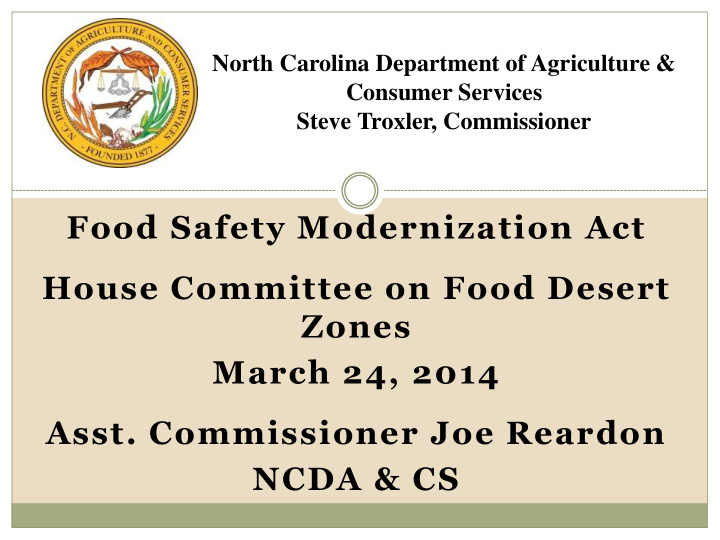



North Carolina Department of Agriculture & Consumer Services Steve Troxler, Commissioner Food Safety Modernization Act House Committee on Food Desert Zones March 24, 2014 Asst. Commissioner Joe Reardon NCDA & CS
2 Food Safety Modernization Act FSMA Signed into law January 4, 2011 Focus on prevention and risk-based preventive controls Provides new enforcement authorities including authority to ensure safety of imported foods Directs the creation of an integrated food safety system in partnership with State and local authorities.
3 Why is this law necessary? Globalization 1 in 6 FDA regulated food products is imported Food supply more high-tech and complex More complex foods in the marketplace New hazards in foods not previously seen Shifting demographics Growing “at risk” population
4 The Public Health Imperative Foodborne illness is a significant burden About 48 million (1 in 6 Americans) get sick each year 128,000 are hospitalized 3,000 die Immune-compromised individuals more susceptible Foodborne illness is not just a stomach ache — it can cause life-long chronic disease
5 Main Themes of FSMA Prevention Inspection, Enhanced Compliance, Partnerships and Response Import Safety
6 Proposed Rules Produce Safety Preventive Controls for Human Food Preventive Controls for Food for Animals Foreign Supplier Verification Program Third Party Accreditation Intentional Adulteration Sanitary Transportation of food
7 Tester Amendment Provides regulatory relief for small farms and facilities Establishes a “qualified” exemption for farms and “qualified facility” exemption for facilities based on sales: Total annual sales (food) under $500,000 and; Majority of sales to qualified end users (consumers) in same state or within 275 miles Includes provisions for modified requirements
8 Tester Amendment Produce Safety Rule Qualified exemption for covered produce farms that meet sales requirements If eligible for qualified exemption, the farm must comply with modified requirements: Labeling at point of sale (placard or label on product if required) No requirement to notify FDA of qualified status
9 Tester Amendment Preventive Controls Rule Qualified facility exemption for very small businesses and those that meet sales requirements Eligible facilities must comply with modified requirements and required notification to FDA of: Qualified Facility status, and; Compliance with modified requirements, or Compliance with non-federal regulation (state inspection) and labeling compliance
A 10 Produce Safety Rule Applies to farms that grow, harvest, pack or hold produce commonly consumed raw Science- and risk-based, considers practices and commodities: Focus on routes of microbial contamination Excludes produce rarely consumed raw and produce that is commercially processed Flexible Additional time for small farms to comply Variances and alternatives
11 Standards for Produce Safety Focus on routes of microbial contamination Agricultural water Biological soil amendments of animal origin Domesticated and wild animals Equipment, tools, buildings and sanitation Worker health and hygiene Growing, harvesting, packing and holding activities Specific requirements for sprouts
12 Preventive Controls for Human Food Rule Applies risk-based preventive principles to the manufacturing, processing, packing and holding of food for humans Facilities, unless otherwise exempt, would be required to implement a written food safety plan that focuses on preventing hazards in foods Includes regulation of “on - farm mixed type” facilities Updated Good Manufacturing Practices
13 Hazard Analysis and Risk-Based Preventive Controls Process controls Food allergen controls Sanitation controls Recall plan
14 Preventive Controls for Food for Animals Rule Analogous to preventive controls rule for human food; requires risk based preventive controls Covers facilities that manufacture, process, pack or hold animal food, raw materials or ingredients Covers products such as pet food, livestock feed and human food (co-product) that is sold for use as animal food or animal food ingredient
15 Foreign Supplier Verification Program Rule Importers would be responsible for ensuring that the imported food meets FDA safety standards Importers required to develop, maintain, and follow an FSVP for each food imported, unless exempt The rule provides flexibility based type of food, size of importer, nature of hazard in food and control of hazard
16 Third Party Accreditation Rule Rule establishes a voluntary program for accrediting third-party auditors to conduct food safety audits of foreign facilities and their foods FDA will recognize accreditation bodies, which will in turn accredit third-party auditors under the program FDA can directly accredit third-party auditors in limited circumstances
17 Intentional Adulteration Rule Rule requires that domestic and foreign facilities address vulnerable processes in their operations to prevent acts on the food supply intended to cause large-scale public harm Requires that facilities covered under the rule develop and implement a written food defense plan that addresses significant vulnerabilities in the food operation
18 Sanitary Transportation of Food Rule Rule establishes requirements to ensure the safety of human and animal food during transportation This proposed rule establishes sanitation requirements for vehicles and transportation equipment, transportation operations, training, and recordkeeping Applies to shippers, receivers and carriers who transport food by motor or rail vehicle
19 Challenges Enormous workload 7 new rules, numerous guidance documents, reports must be completed in short timeframe Tight deadlines Changes won’t appear overnight Building new system will be a long-range process Resources Funding to state agencies, Land grant universities
20 Timeline/Next Steps FDA will re-release key portions of some rules for public comment in summer 2014 Final Rules scheduled for release 2015 and 2016 Compliance with the rules will generally begin 1 year after final rule issued; smaller facilities have additional time Education and Outreach: Educate before Regulate
21 Thank You! Joe Reardon Assistant Commissioner North Carolina Department of Agriculture & Consumer Services Joe.Reardon@ncagr.gov
Recommend
More recommend